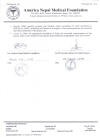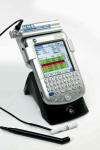Project Description
Project ID
06BPK001
Project Type
Funded Project - Normal Project
Project Title
Monitoring Pediatric Ophthalmology in Eastern Nepal
Project Summary
According to WHO bulletin 20011, the number of blind children in the world is approximately 1.4 million. Three-quarters of these children live in the poorest regions of Africa and Asia. In Nepal, most of the childhood eye diseases are prevalent in rural part of Nepal due to poverty and lack of knowledge. More than 90% of these diseases are preventable or treatable. Vast majority of these children are brought to hospital in very late stages when possibility of salvaging vision is minimum.
The project will help combating the problem in following ways:
- Provide free medical and surgical services to the children deprived of such facilities.
- Increase community awareness about the disease
Location
Rural areas of Morang and Sunsari districts of Eastern Nepal
Time Frame
1 year
Institution
BP Koirala Institute of Health Sciences
Contact
Dr. Srijana Adhikari, MD
Department Ophthalmology
B. P. Koirala Institute of Health Sciences, Ghopa
Dharan, Nepal
email: srij_a![]() yahoo.com
yahoo.com
Telephone: 977-25-525555-2320 (Off), 977-98-4204-1454
ANMF/Nepal Project Manager
Shankar Rai, MD
ShankarRai![]() anmf.net
anmf.net
ANMF/America Project Manager
Dr. Sunil Sharma
SunilSharma![]() anmf.net
anmf.net
Project Description
Childhood blindness in Nepal.
There are about 5.5 million children in Nepal below 15 years of age.3 The Nepal Blindness Survey conducted in 1981 showed, xerophthalmia ocular infection, and cataract to be the leading causes of blindness in children.2 Other ocular conditions that causes visual morbidity in children are, trauma, uncorrected refractive error, and strabismus.
More than 90% of these diseases are either preventable or treatable. These are the major causes of avoidable childhood blindness in Nepal.
Prevention and treatment of childhood blindness is disease specific.
Xeropthalmia is the condition occurring due to vitamin A deficiency in children. For Vitamin A deficiency, at a cost of only 5 US cents a dose, vitamin A supplements reduce child mortality by up to 34% in areas where Vitamin A deficiency is a public health problem.
The causes of Congenital and developmental cataract in children are idiopathic, hereditary, traumatic congenital rubella etc4.Cataract in children differs in many ways from adults . The intra operative technique and the post operative management of childhood cataract is still a challenge in ophthalmologists s community. Timely diagnosis and surgery is very important in these cases to acquire good visual potential.
Other diseases like congenital glaucoma, ocular malignancy like retinoblastoma, and other congenital and developmental eye diseases are common in the children. One of the most common cause of ocular morbidity in school going children in Nepal is the uncorrected refractive error which cause amblyopia (lazy eye)5.
The most important factor contributing to this burden of childhood blindness in the community is the lack of knowledge about these diseases. Most of the children brought to the hospital are already in very late stage.
Project Justification
WHO has assigned childhood blindness as one of the top five priority problems in its ambitious program vision 20201, the right to sight. In Nepal, the pediatric Ophthalmology facility is in rarity even in the urban areas. In eastern region, few pediatric ophthalmology services are present in some eye centres but which is very insufficient for the problem in large community people. This project will help diagnosing the eye disease and giving timely intervention to those population who are deprived of these facilities due to lack of knowledge and poverty.
Project output:
Provide free medical checkups, medications and the surgical treatment to the children of rural areas of Nepal suffering from treatable eye problems.
Evaluation of the Magnitude of the problem (prevalence of eye diseases in children) will be evaluated and the baseline data regarding the medical and surgical intervention and their outcome will be generated for further research and planning..
Project activity:
The total duration of the project will be of one year. In this period as much VDC as possible will be covered. In the beginning, the VDCs of Sunsari and Morang districts will be covered. If the goal of project meet in less than one year, then more other VDC will be included in the projects.
The project will run in two areas:
In the community:
- The children eye health camps in the local VDCs, in every one week.
- The manpower included in the eye health check up will be a pediatric Ophthalmologist, Ophthalmology, resident Ophthalmic technician, driver.
- Distribution of free medications to these children.
- Give pediatric vision screening training to the local village health professionals (ANM) .
- Provide health education to the local community through posters and lectures.
In the Hospital:
- As eye surgery in children require general anesthesia and sophisticated instruments, it is not possible to carry out this in the community. Children in whom surgery is indicated will be brought to the hospital for free surgery and hospital stay.
- Parents will be counseled for the intensive post operative management of these children as this is very crucial in pediatric surgeries like cataract.
Personnel required:
A pediatric Ophthalmologist
An Ophthalmology resident
An Ophthalmology technician
References:
- Gilbert C, Foster A. Childhood blindness in the context of VISION 2020--the right to sight. Bull World Health Organ. 2001;79(3):227-32.
- Brilliant LB, Pokhrel RP, Grasset NC, et al. Epidemiology of blindness in Nepal. Bull World Health Organ. 1985;63(2):375-86.
- Nepal population census 2001. http://www.mope.gov.np/population/chapter1.php visited on 24th July 2006.
- Pediatric cataracts, in BCSC section IV Pediatric ophthalmology and Strabismus
- B P Nepal, S Koirala, S Adhikary, and A K Sharma Br J Ophthalmol 2003; 87: 531-534. doi:10.1136/bjo.87.5.531
Material Requested
Alcon Accurus, VS 300 vitrectomy machine - 1 total amount $9,000
pediatric vision screening chart: 2 x $50 = $100
Training Requested
None
Advisors/Instructors Requested
None
Travel/Expenses Requested
$10 per month with total of 12 x $10 = $120
Grants/Stipends Requested
None. Will be provided by B. P. Koirala Institute of Health Sciences.
Other Items Requested
Other expenses will be covered by B. P. Koirala Institute of Health Sciences.
Total Funds Requested
$9,220
Budget
Vitrectomy machine: $9,000
Pediatric vision screening charts: 2 x $50 = $100
Travel: $120
Total: $9,220
Additional Information
This project has been planned to run for the period of one year. If the target population can not be covered within this time frame, then the project will be supported by B. P. Koirala Institute. Once the foundation of the project is laid and the works get started, the further sustaining of the project will be much cheaper and cost effective.
Project Status
9/13/06 Request received by ANMF/Nepal 9/12/07 Project approved by ANMF/Nepal 9/19/07 Project approved by Projects Committee 9/23/07 Project approved provisionally by Board, Dr. Sunil Sharma appointed project manager who will clarify details with BPK 10/8/07 Project approved for full funding 1/28/08 Funds transferred to ANMF/Nepal 3/4/08 Memorandum of understanding signed and funds transferred to B. P. Koirala Institute of Health Sciences

5/24/08 Update reporting good progress received from BPK project manager




6/19/08 Update reporting progress to date
11/20/08 Vitrectomy machine has arrived at Kathmandu airport 12/11/08 Update received - vitrectomy machine has arrived at B. P. Koirala Institute of Health Sciences 12/29/08 Update received - vitrectomy machine installed at B. P. Koirala Institute of Health Sciences
2/26/09 Update received - surgeries performed with new equipment


